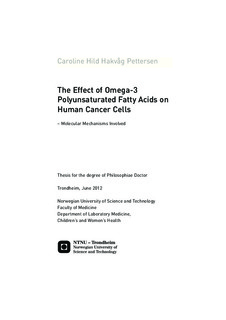| dc.contributor.author | Pettersen, Caroline Hild Hakvåg | nb_NO |
| dc.date.accessioned | 2014-12-19T14:19:42Z | |
| dc.date.available | 2014-12-19T14:19:42Z | |
| dc.date.created | 2012-08-20 | nb_NO |
| dc.date.issued | 2012 | nb_NO |
| dc.identifier | 545447 | nb_NO |
| dc.identifier.isbn | 978-82-471-3636-2 (printed ver.) | nb_NO |
| dc.identifier.isbn | 978-82-471-3637-9 (electronic ver.) | nb_NO |
| dc.identifier.uri | http://hdl.handle.net/11250/263865 | |
| dc.description.abstract | Fatty fish and cod liver oil have been common ingredients in the Norwegian diet for centuries. In the latter half of the 1800s the apothecary Møller produced pure cod liver oil for medicinal use. In the 1950s and 1960s, the Norwegian Professor Notevarp found that fish oil contained the omega-3 polyunsaturated fatty acid (n-3 PUFA) docosahexaenoic acid (DHA). He was also the first to describe a beneficial effect of n-3 PUFAs on cardiovascular disease. In the 1970s, the doctors Bang and Dyerberg found that Greenland Inuits had low incidence of cardiovascular disease, and related it to increased n-3 PUFA content in the blood. Some epidemiological observational studies have found that n-3 PUFAs may reduce the incidence of some cancer types like colon cancer; however, the results have not been consistent. Yet, some clinical studies, as well as several animal and cell culture experiments have shown that n-3 PUFAs have a growth inhibiting effect on some types of cancers, but the mechanisms behind this effect are unclear. The aim of the studies has been to explore the molecular mechanisms behind the growth reducing effect of n-3 PUFAs on cancer cells in vitro.
Supplementation of DHA to human colon cancer cells (SW620) in culture strongly reduced cell growth in physiological relevant concentrations, and gene expression analysis indicated changed expression of thousands of genes involved in different biological pathways. The DHA treatment resulted in stress in the endoplasmic reticulum (ER) and induction of unfolded protein response (UPR). Some of the main functions of the ER are protein folding, regulation of calcium levels, as well as synthesis of lipids and sterols. Disruption of any of these mechanisms such as accumulation of unfolded/misfolded proteins may result in ER stress and induction of UPR. This stress response is characterized by phosphorylation of the eukaryotic translation initiation factor 2 α (eIF2α-P) which was induced as early as 3 hours after DHA administration. Increased eIF2α-P arrests protein translation, reduces the cell cycle regulator cyclin D and induces cell cycle arrest, allowing the cells to repair the damage/restore ER homeostasis. However, if damage is too severe, the cell death machinery (apoptosis) will be activated.
The gene expression results also indicated changes in calcium and cholesterol homeostasis. Addition of DHA to SW620 cells increased the intracellular calcium level, probably as a result of calcium release from the ER and uptake of exogenous calcium. Cellular cholesterol synthesis is regulated by e.g. sterol regulatory element binding protein 2 (SREBP2). Despite active SREBP2, only some of its target genes were up-regulated by DHA supplementation. New synthesis of cholesterol and incorporation of newly synthesized cholesterol into cholesteryl esters were down-regulated, while total cholesterol levels were not markedly affected. Changes in calcium homeostasis were further investigated using a human leukemia cell line (HL-60) and a mutant HL-60 clone (E2R2) which is resistant towards the calcium homeostasis-disturbing chemical econazole. The HL-60 cells were strongly growth inhibited by addition of eicosapentaenoic acid (EPA), while the growth of E2R2 cells was only moderately affected. Gene expression analysis and induction of eIF2α-P in EPA-treated HL-60 cells indicated changes in calcium homeostasis and induction of UPR in the mother cell line, while there was no evidence of ER stress and UPR in E2R2 cells.
Administration of DHA to SW620 cells also resulted in changed expression of several genes and proteins involved in regulation of cell cycle and cell death. Protein levels of survivin, livin and nuclear factor κ B (NFκB) were reduced, which is interesting since they are induced in different tumors and are known targetproteins of chemotherapy. Whether n-3 PUFAs have a place as supplements to clinical cancer treatment depends, however, on further research within this field. | nb_NO |
| dc.language | eng | nb_NO |
| dc.publisher | Norges teknisk-naturvitenskapelige universitet, Det medisinske fakultet, Institutt for laboratoriemedisin, barne- og kvinnesykdommer | nb_NO |
| dc.relation.ispartofseries | Dr.ingeniøravhandling, 0809-103X; 2012:172 | nb_NO |
| dc.relation.ispartofseries | Dissertations at the Faculty of Medicine, 0805-7680; 555 | nb_NO |
| dc.relation.haspart | Jakobsen, Caroline Hild; Størvold, Gro Leite; Bremseth, Hilde; Follestad, Turid; Sand, Kristin; Mack, Merete; Olsen, Karina Standahl; Lundemo, Anne Gøril; Iversen, Jens Gustav; Krokan, Hans Einar; Schønberg, Svanhild Arentz. DHA induces ER stress and growth arrest in human colon cancer cells. Journal of Lipid Research. (ISSN 0022-2275). 49(10): 2089-100, 2008. <a href='http://dx.doi.org/10.1194/jlr.M700389-JLR200'>10.1194/jlr.M700389-JLR200</a>. <a href='http://www.ncbi.nlm.nih.gov/pubmed/18566476'>18566476</a>. | nb_NO |
| dc.relation.haspart | Slagsvold, Jens Erik; Pettersen, Caroline Hild Hakvåg; Follestad, Turid; Krokan, Hans Einar; Schønberg, Svanhild Arentz. The antiproliferative effect of EPA in HL60 cells is mediated by alterations in calcium homeostasis.. Lipids. (ISSN 0024-4201). 44(2): 103-13, 2009. <a href='http://dx.doi.org/10.1007/s11745-008-3263-5'>10.1007/s11745-008-3263-5</a>. <a href='http://www.ncbi.nlm.nih.gov/pubmed/19020915'>19020915</a>. | nb_NO |
| dc.relation.haspart | Slagsvold, Jens E; Pettersen, Caroline H H; Størvold, Gro L; Follestad, Turid; Krokan, Hans E; Schønberg, Svanhild A. DHA alters expression of target proteins of cancer therapy in chemotherapy resistant SW620 colon cancer cells.. Nutrition and Cancer. (ISSN 0163-5581). 62(5): 611-21, 2010. <a href='http://dx.doi.org/10.1080/01635580903532366'>10.1080/01635580903532366</a>. <a href='http://www.ncbi.nlm.nih.gov/pubmed/20574922'>20574922</a>. | nb_NO |
| dc.title | The Effect of Omega-3 Polyunsaturated Fatty Acids on Human Cancer Cells: – Molecular Mechanisms Involved | nb_NO |
| dc.type | Doctoral thesis | nb_NO |
| dc.contributor.department | Norges teknisk-naturvitenskapelige universitet, Det medisinske fakultet, Institutt for laboratoriemedisin, barne- og kvinnesykdommer | nb_NO |
| dc.description.degree | PhD i molekylærmedisin | nb_NO |
| dc.description.degree | PhD in Molecular Medicine | en_GB |

